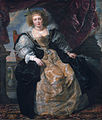
Wedding dress

| Part of a series on |
| Western dress codes and corresponding attires |
|---|
|
Legend:

|
A wedding dress or bridal gown is the dress worn by the bride during a wedding ceremony. The color, style and ceremonial importance of the gown can depend on the religion and culture of the wedding participants. Wedding dresses hold a significant place in fashion, symbolizing personal expression, and cultural traditions and societal values. In Western culture, the wedding dress is most commonly white, a fashion made popular by Queen Victoria when she married in 1840.[1] In Eastern cultures, brides often choose red to symbolize auspiciousness.[1] These wedding dresses often represent a blend of heritage and contemporary trends, making them a pivotal aspect of bridal fashion and a reflection of evolving style in society.

Fashion of wedding dresses
Wedding dress fashion has evolved significantly, shaped by shifts in aesthetic preferences, technological advancements, and broader cultural trends. Historically, bridal attire featured elaborate designs with structured silhouettes and intricate detailing, reflecting the prevailing styles of their time.[2] In more recent decades, minimalist and modern designs have gained popularity, emphasizing simplicity and personal expression. Wedding dresses continue to adapt to contemporary fashion trends while retaining elements of tradition, offering a wide range of styles that allow brides to express their individuality.[2]

Current fashion
In the early 21st century, many wedding dresses were sleeveless and strapless.[3] Other brides preferred styles with sleeves, higher necklines, and covered backs.[3]

The latest wedding dress designs, as of 2024, feature drop-waist silhouettes, convertible gowns, intricate crystal embellishments, tulle, and gowns that display vintage charm.[4]

History of the wedding dress
The history of wedding dresses encompasses a diverse array of traditions and cultural practices, each shaped by the social, religious, and economic contexts of their time. In Western cultures, white wedding gowns have symbolized purity and grace since the 19th century, whereas Eastern cultures often feature elaborate, colorful garments imbued with symbolic meanings unique to each region.[5]

Western Culture

Weddings performed during and immediately following the Middle Ages were often more than a personal union between two individuals. They frequently symbolized a union between families, businesses, or even nations. These ceremonies were driven more by political considerations than romantic love, particularly among the nobility and the higher social classes. Brides were expected to dress in a way that reflected the status of their families, representing more than just themselves during the ceremony. Brides from wealthy families often wore rich colors and exclusive fabrics, wearing bold colors and layers of furs, velvet, and silk. The attire of the bride was a testament to the wealth and social standing of her family. Brides from lower social strata wore their best church dress on their wedding day. The amount and the price of material a wedding dress contained was a direct reflection of the bride's social standing and indicated the extent of the family's wealth to wedding guests.

Color of wedding dresses
The first documented instance of a royal bride wearing a white wedding dress was that of Philippa of England. She wore a tunic with a cloak in white silk bordered with squirrel and ermine in 1406, when she married Eric of Pomerania.[6][7] Similarly, Mary, Queen of Scots, wore a white wedding dress in 1559 when she married her first husband, Francis, the Dauphin of France, because it was her favorite color, although white was then the color of mourning for French queens.[8][9]

This was not a widespread trend, however: prior to the Victorian era, a bride was married in any color, black being popular in Finland.[10]

White became a popular option in 1840, after the marriage of Queen Victoria to Albert of Saxe-Coburg and Gotha, when Victoria wore a white gown trimmed with Honiton lace. Illustrations of the wedding were widely published, and many brides opted for white in accordance with the Queen's choice.[11] Although white was later assumed to symbolize virginity, it was originally blue that represented purity, piety, and fidelity, and was associated with the Virgin Mary.[12]

Despite the rise in popularity of white wedding dresses, brides continued to follow contemporary fashion trends. In the early 1900s, clothing included a lot of decorations, such as lace or frills. This was also adopted in wedding dresses, where decorative frills and lace were common. For example, in the 1920s, they were typically short in the front with a longer train in the back and were worn with cloche-style wedding veils. This tendency to follow current fashions continued until the late 1960s, when it became popular to revert to long, full-skirted designs reminiscent of the Victorian era.[1]

Since the mid-20th century, white has been the dominant color for Western wedding dresses, though "wedding white" includes shades such as eggshell, ecru, and ivory.[13] However, white is not the universal color of wedding dresses. In Mexico, for example, red is a popular color.[14]

In the Church of Jesus Christ of Latter-day Saints the color white is used as a symbol of purity, innocence, and cleanliness, particularly in religious ceremonies, including weddings.[15] For weddings in the temple, white clothing is also worn by all participants during the ceremony, both men and women, to symbolize unity and equality before God.[16][17] The brides are instructed to wear white dresses that are modest in design and fabric and free of elaborate decoration.[18]

Eastern culture


Many wedding dresses in China, India, Bangladesh, and Pakistan are red; the traditional Indian color representing good luck and auspiciousness.[1] Vietnamese wedding dresses (in the traditional form of áo tấc the ancient Ao dai) were dark blue. Today, many women choose other colors besides red. In modern mainland Chinese weddings, the bride may wear Western dresses of any color and a traditional costume for the wedding tea ceremony.

In modern Taiwanese weddings, the bride generally picks red (following Chinese tradition) or white (more Western) silk for the wedding gown material, but most will wear the red traditional garment for their formal wedding banquets. Traditionally, the father of the bride is responsible for the wedding banquet hosted on the bride's side and the alcohol (specifically called "xi-jiu," confusingly the same as what the wedding banquet itself is called) consumed during both banquets. While the wedding itself is often based on the couple's choices, the wedding banquets are a symbolic gesture of "thanks" and appreciation, to those who have raised the bride and groom (such as grandparents and uncles) and those who will continue to be there to help the bride and groom in the future. Thus out of respect for the elders, wedding banquets are usually done formally and traditionally.


Red saris, lehengas, and salwar kameez are traditional garment options for brides in Indian cultures. The fabric of choice is also traditionally silk, regardless of garment type. Over time, color options and fabric choices for Indian brides have expanded. Today fabrics like crepe, Georgette, charmeuse, and satin are used, and colors have been expanded to include gold, pink, orange, maroon, brown, and yellow as well.

Traditionally, a Kurdish first-time bride would wear a red dress for her wedding to symbolize the postcoital bleeding she will experience when she loses her virginity while a Kurdish bride who used to be married before would wear pink. Today, many Kurds associate red wedding dresses with impoverished Kurdish rural society and it is no longer commonly worn.[19][20][21]

A Japanese wedding usually involves a traditional pure white kimono for the formal ceremony, symbolizing purity and maidenhood. The bride may change into a red kimono for the events after the ceremony for good luck.

The Javanese people of Indonesia wear a kebaya, a traditional kind of blouse, along with batik.

In the Philippines, variations of the Baro't saya adapted to the white wedding tradition are considered to be wedding attire for women, along with the barong tagalog for men. Various tribes and Muslim Filipinos don other forms of traditional dress during their respective ceremonies.

Native American culture

The indigenous peoples of the Americas have varying traditions related to weddings and thus wedding dresses. A Hopi bride traditionally had her garments woven by the groom and any men in the village who wished to participate.[22] The garments consisted of a large belt, two all-white wedding robes, a white wedding robe with red stripes at the top and bottom, white buckskin leggings and moccasins, a string for tying the hair, and a reed mat in which to wrap the outfit. This outfit also served as a shroud, since these garments would be necessary for the trip through the underworld.

A Pueblo bride wore a cotton garment tied above the right shoulder, secured with a belt around the waist.

In the traditions of the Delaware, a bride wore a knee-length skirt of deerskin and a band of wampum beads around her forehead. Except for fine beads or shell necklaces, the body was bare from the waist up. If it was a winter wedding, she wore deerskin leggings and moccasins and a robe of turkey feathers. Her face was painted with white, red, and yellow clay.

The tribes of Northern California (which include the Klamath, the Modoc, and the Yurok) had a traditional bridal dress woven in symbolic colors: white for the east, blue for the south, yellow (orange) for the west; and black for the north. Turquoise and silver jewelry were worn by both the bride and the groom in addition to a silver Concho belt. Jewelry was considered a shield against evils including hunger, poverty, and bad luck.

Gallery of wedding dresses
Historical Western European wedding dresses
-
Detail from The Marriage by Nicolo da Bologna, 1350s.
-
Helena Fourment, second wife of Peter Paul Rubens, painted by Rubens in her wedding dress, 1630.
-
Sophia Magdalena of Denmark's wedding dress, 1766. The Royal Armoury in Sweden.
Wedding dresses from different areas of the world
-
Traditional Kazakh wedding dress
-
Traditional Armenian wedding dress
-
Bride in a wedding dress, Podhale, the Tatra Mountains
-
Yemenite Jewish bride in Israel, 1950s
-
Wedding of Tewfik Pasha and Emina Ilhamy, Cairo, Egypt, January 1873
-
Chinese couple wearing traditional wedding hanfu
South Asian dresses
-
Indian Hindu bride in red Sari
-
Indian Christian bride in white Sari
-
Nepali bride of Kathmandu, 1941
-
Bengali Hindu bride during Sindur Daan
-
Marathi wedding
-
Sri Lankan wedding
Southeast Asian dresses
-
Khmer (Cambodian) couple dressed in traditional wedding outfits
-
Vietnamese couple in traditional dress
-
Couple dress in traditional Thai outfits
-
Couple dressed in traditional Burmese outfits
-
Bali Hindu wedding dress
-
Reenactment of the royal wedding ceremony of King Gojong and Queen Myeongseong
Modern Western-style dresses
-
A bride in 1968, wearing a dress reflecting the styles of the time
-
Patricia Nixon Cox with her father Richard Nixon, 1971
-
Taiwanese couple dressed Western-style for keepsake photos in the park, 1989
-
American bride marrying a Scotsman wearing a kilt, 1996
-
New Orleans bride wearing a strapless, sleeveless gown, 2006
See also
- Bridal crown
- Christian clothing
- Godey's Lady's Book
- Religious clothing
- Victorian fashion
- Wedding dress of Camilla Parker Bowles
- Wedding dress of Grace Kelly
- Wedding dress of Jacqueline Bouvier
- Wedding dress of Kate Middleton
- Wedding dress of Lady Diana Spencer
- Wedding dress of Meghan Markle
- Wedding dress of Princess Alexandra of Denmark
- Wedding dress of Princess Anne
- Wedding dress of Princess Elizabeth
- Wedding dress of Princess Margaret
- Wedding dress of Princess Mary of Teck
- Wedding dress of Queen Victoria
- Wedding dress of Sarah Ferguson
- Wedding dress of Sophie Rhys-Jones
- Wedding dress of Victoria, Princess Royal
- Wedding dress of Wallis Warfield
References
- ^ a b c d Brennan, Summer (2017-09-27). "A Natural History of the Wedding Dress". JSTOR Daily. Retrieved 2024-10-21.
- ^ a b Chrisman-Campbell, Kimberly (2020). The way we wed: a global history of wedding fashion. Philadelphia: Running Press. ISBN 978-0-7624-7028-0.
- ^ a b "Wedding Dress Ideas, Designers & Inspiration". Brides. Retrieved 2024-10-21.
- ^ Wax, Shelby (2024-04-09). "The Biggest Wedding Dress Trends From New York Bridal Fashion Week". Vogue. Retrieved 2024-10-16.
- ^ Currie, Dawn H. (1993-10-01). ""Here Comes the Bride": The Making of a "Modern Traditional" Wedding in Western Culture". Journal of Comparative Family Studies. 24 (3): 403–421. doi:10.3138/jcfs.24.3.403. ISSN 0047-2328.
- ^ "Wedding white doesn't mean what you think it means". Ivy Bridal Studio. 3 March 2014. Archived from the original on 11 May 2016. Retrieved 21 November 2014.
Princess Philippa of England is the first recorded princess to have worn white during her wedding in 1406, with her attire consisting of a tunic and cloak in white silk, but it wasn't until Queen Mary that the white dress would explode in popularity
- ^ "The History of Matrimony". Amalfi Wedding Planner. Archived from the original on 6 May 2006.
- ^ "Mary, Queen of Scots' first wedding day". Madame Guillotine. 24 April 2011. Archived from the original on 23 June 2015. Retrieved 21 November 2014.
Mary's choice of a white wedding dress was an unusual one, particularly as white was more traditionally worn by royal ladies when they were in dieul blanc mourning but in this as in other things the strong willed Mary may well have been an innovator, keen to not just impress her own taste on her wedding day (after all, she hadn't been allowed the privilege of choosing her groom) but also emphasise her virginity and show off her famously pale redheaded beauty, which would have been accentuated by a pure white dress.
- ^ "Elizabeth I Facts". The Elizabeth Files. 23 August 2009. Archived from the original on 24 July 2018. Retrieved 21 November 2014.
Her favourite dress colours were white and black which symbolised purity.
- ^ Pelo, June. "Old Marriage Customs in Finland". Sydaby.eget.net. Retrieved 19 January 2019.
- ^ "Royal Weddings 1840-1947". Royal Collection Trust. Retrieved 19 January 2019.
- ^ Ashliman, DL (2004). Folk and Fairy Tales: A Handbook–Greenwood Folklore Handbooks. ABC-CLIO. p. 9. ISBN 9780313058592.
- ^ Stewart, Jude (14 February 2011). "The Bride Wore Chartreuse: Why (Most) Wedding Dresses are White". Print. Retrieved 19 January 2019.
- ^ "Traditional Mexican dress · V&A". Victoria and Albert Museum. Retrieved 2024-10-21.
- ^ "Preparing to Enter the Holy Temple". Preparing to Enter the Holy Temple. The Church of Jesus Christ of Latter-day Saints. Archived from the original on 16 December 2021. Retrieved 16 December 2021.
- ^ "Lesson 5: Learning from the Lord through Symbols". Endowed from on High: Temple Preparation Seminar Teacher’s Manual. The Church of Jesus Christ of Latter-day Saints. Archived from the original on 16 December 2021. Retrieved 16 December 2021.
- ^ "Why Symbols?". Ensign. The Church of Jesus Christ of Latter-day Saints. February 2007. Archived from the original on 16 December 2021. Retrieved 16 December 2021.
- ^ "27. Temple Ordinances for the Living". General Handbook: Serving in The Church of Jesus Christ of Latter-day Saints. The Church of Jesus Christ of Latter-day Saints. Retrieved 20 September 2021.
- ^ Allison, Christine (1996). Kurdish Culture and Identity. Bloomsbury Academic. p. 154. ISBN 9781856493291.
- ^ Russel, Jan (November 2007). They Lived to Tell the Tale. Lyons Press. ISBN 9781599216393.
- ^ Smothers Bruni, Mary Ann (1995). Journey Through Kurdistan. Texas Memorial Museum. p. 57.
- ^ "Hopi traditions reinforce sacredness of marriage - The Times-Independent". The Times-Independent - The Times-Independent. 2010-06-17. Retrieved 2022-06-14.
External links
- Fashion Plates of Wedding Dresses from 1820-1929 from The Metropolitan Museum of Art Libraries
- Wedding Dresses at Chicago History Museum Digital Collections Archived 2012-07-29 at the Wayback Machine
- Wedding dress, 1900, in the Staten Island Historical Society Online Collections Database
- Wedding dress, 1951, in the Staten Island Historical Society Online Collections Database
See what we do next...
OR
By submitting your email or phone number, you're giving mschf permission to send you email and/or recurring marketing texts. Data rates may apply. Text stop to cancel, help for help.
Success: You're subscribed now !
































